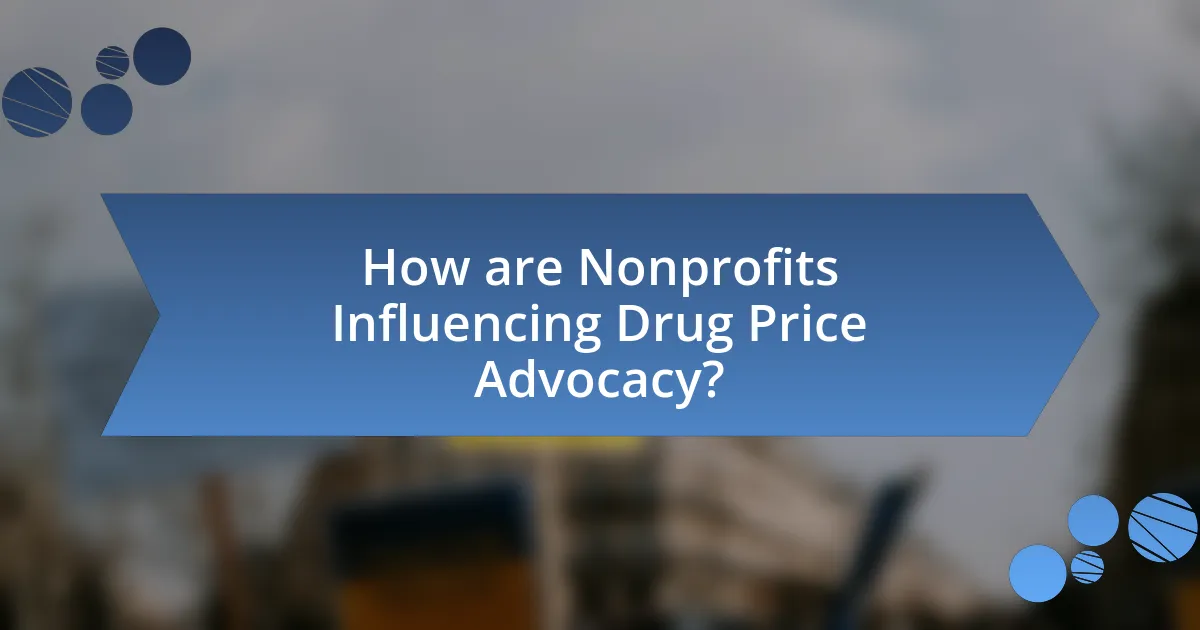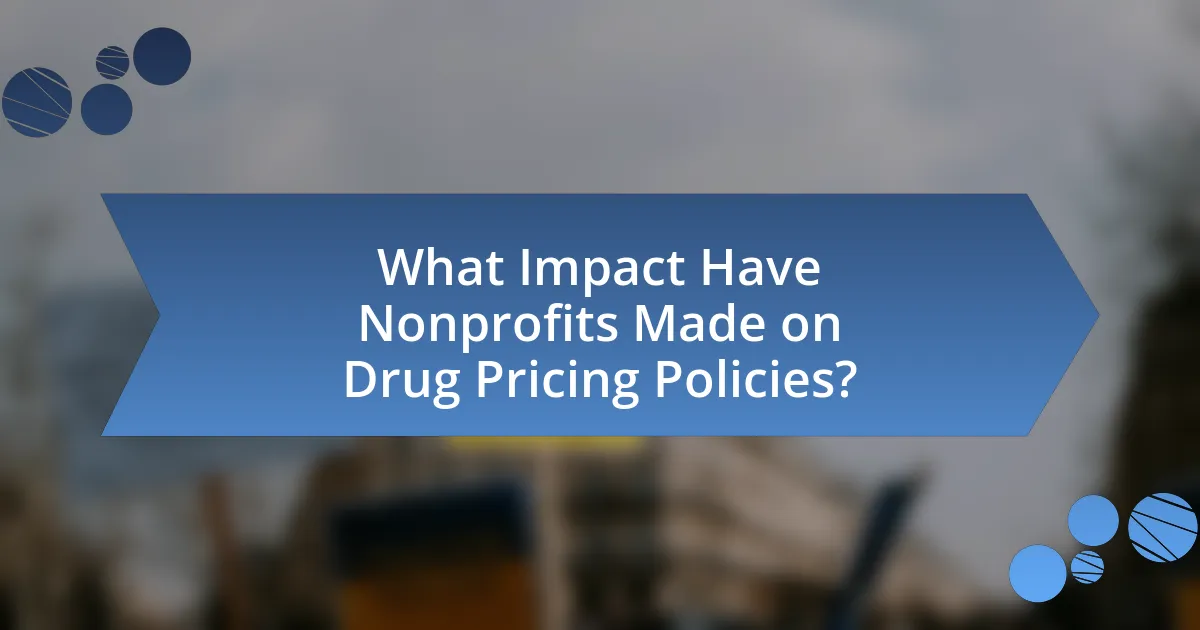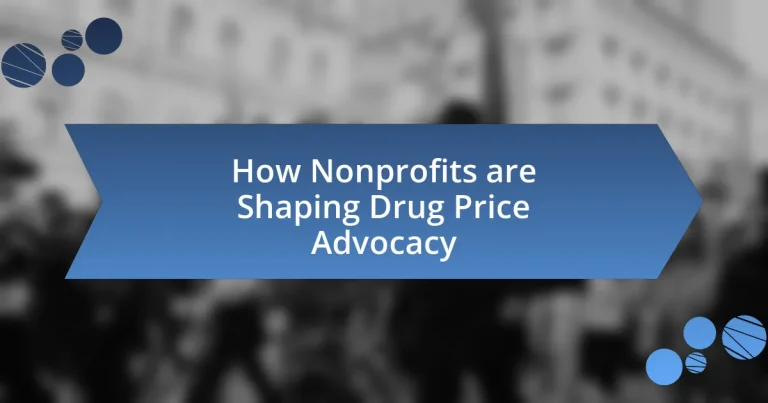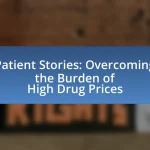Nonprofits are playing a pivotal role in drug price advocacy by raising public awareness and lobbying for policy changes aimed at making medications more affordable. Organizations such as Patients for Affordable Drugs and the AIDS Healthcare Foundation utilize research and grassroots mobilization to highlight the financial burdens of high drug prices on patients, advocating for legislative reforms like price transparency and Medicare negotiations. The article explores the strategies employed by nonprofits, the challenges they face, and the impact of their advocacy efforts on drug pricing policies, emphasizing the importance of collaboration, data-driven research, and community engagement in driving meaningful change in healthcare access and affordability.

How are Nonprofits Influencing Drug Price Advocacy?
Nonprofits are influencing drug price advocacy by mobilizing public awareness and lobbying for policy changes that promote affordable medication. Organizations such as the Patients for Affordable Drugs and the AIDS Healthcare Foundation actively campaign against high drug prices, utilizing research and data to highlight the financial burden on patients. For instance, a report by the House of Representatives in 2019 indicated that Americans pay nearly four times more for prescription drugs than citizens in other developed countries, a statistic often cited by nonprofits to advocate for legislative reforms. These organizations also engage in grassroots efforts, encouraging patients to share their stories, which amplifies the urgency for change and pressures lawmakers to act on drug pricing issues.
What roles do nonprofits play in drug price advocacy?
Nonprofits play a crucial role in drug price advocacy by raising awareness, influencing policy, and providing support for patients. These organizations often conduct research to highlight the disparities in drug pricing and mobilize public opinion to push for legislative changes. For instance, groups like the Patients for Affordable Drugs Now have successfully lobbied for price transparency and have advocated for the negotiation of drug prices in Medicare, demonstrating their impact on policy discussions. Additionally, nonprofits often collaborate with other stakeholders, including healthcare providers and patient advocacy groups, to create a unified front that amplifies their message and increases pressure on lawmakers to address high drug costs.
How do nonprofits raise awareness about drug pricing issues?
Nonprofits raise awareness about drug pricing issues through advocacy campaigns, educational initiatives, and community engagement. These organizations often utilize social media platforms, public events, and partnerships with healthcare professionals to disseminate information about the impact of high drug prices on patients. For instance, the nonprofit organization Patients for Affordable Drugs has effectively used online petitions and media outreach to highlight specific cases of exorbitant drug costs, thereby mobilizing public support and influencing policy discussions. Additionally, research indicates that nonprofits play a crucial role in informing the public and policymakers about the need for transparency in drug pricing, as evidenced by studies showing that increased awareness can lead to legislative changes aimed at reducing costs.
What strategies do nonprofits use to advocate for lower drug prices?
Nonprofits advocate for lower drug prices through strategies such as grassroots mobilization, policy advocacy, and public awareness campaigns. Grassroots mobilization involves organizing community members to engage in collective action, which can influence policymakers by demonstrating public support for price reductions. Policy advocacy includes lobbying government officials and participating in legislative processes to push for reforms that promote affordable medications. Public awareness campaigns educate the public about the impact of high drug prices on health and finances, often using data to highlight disparities and the need for change. For instance, organizations like Families USA have successfully mobilized public support and influenced legislation aimed at lowering prescription drug costs.
Why is drug price advocacy important for nonprofits?
Drug price advocacy is important for nonprofits because it enables them to address the critical issue of affordability and access to medications for underserved populations. Nonprofits often serve communities that face significant barriers to healthcare, and advocating for lower drug prices directly impacts their ability to provide essential treatments. For instance, a report from the Kaiser Family Foundation highlights that high drug prices can lead to medication non-adherence, which exacerbates health disparities. By engaging in drug price advocacy, nonprofits can influence policy changes, promote transparency in pricing, and push for regulations that ensure equitable access to necessary medications, ultimately improving health outcomes for vulnerable groups.
How do high drug prices impact public health?
High drug prices negatively impact public health by limiting access to essential medications for patients. When medications are unaffordable, individuals may forgo necessary treatments, leading to worsened health outcomes, increased hospitalizations, and higher overall healthcare costs. For instance, a study published in the Journal of the American Medical Association found that nearly 25% of Americans reported not filling a prescription due to cost, which can exacerbate chronic conditions and lead to preventable complications. This situation creates a cycle of poor health and increased financial strain on both individuals and the healthcare system.
What ethical considerations drive nonprofits to engage in drug price advocacy?
Nonprofits engage in drug price advocacy primarily due to ethical considerations surrounding access to essential medications and health equity. These organizations believe that high drug prices can lead to significant disparities in healthcare access, particularly for low-income and marginalized populations. For instance, a report from the Kaiser Family Foundation highlights that nearly one in four Americans has reported not filling a prescription due to cost, underscoring the ethical imperative for nonprofits to advocate for affordable medications. Additionally, nonprofits often emphasize the moral responsibility to ensure that life-saving treatments are accessible to all, aligning their missions with principles of justice and fairness in healthcare.
What challenges do nonprofits face in drug price advocacy?
Nonprofits face significant challenges in drug price advocacy, primarily due to limited resources, regulatory complexities, and opposition from powerful pharmaceutical companies. Limited funding restricts their ability to conduct extensive research and outreach, which is essential for effective advocacy. Regulatory complexities, such as navigating the legal landscape surrounding drug pricing and patent laws, create barriers to influencing policy changes. Additionally, pharmaceutical companies often have substantial lobbying power and financial resources, making it difficult for nonprofits to compete in shaping public policy. These factors collectively hinder the ability of nonprofits to advocate effectively for lower drug prices and equitable access to medications.
How do funding limitations affect nonprofit advocacy efforts?
Funding limitations significantly hinder nonprofit advocacy efforts by restricting their ability to conduct outreach, mobilize resources, and implement effective campaigns. Nonprofits often rely on grants and donations to finance advocacy initiatives; when funding is scarce, they may struggle to hire skilled staff, develop educational materials, or engage in lobbying activities. For instance, a study by the National Council of Nonprofits found that 70% of nonprofits reported that funding constraints limited their capacity to advocate for policy changes. This lack of financial support can lead to reduced visibility and influence in critical discussions, particularly in areas like drug price advocacy, where sustained efforts are essential for driving legislative change.
What opposition do nonprofits encounter from pharmaceutical companies?
Nonprofits encounter significant opposition from pharmaceutical companies primarily through aggressive lobbying efforts and legal challenges. Pharmaceutical companies often invest heavily in lobbying to influence legislation that affects drug pricing and access, aiming to protect their profit margins. For instance, in 2020, the pharmaceutical industry spent over $300 million on lobbying efforts in the United States alone, focusing on policies that could undermine their pricing strategies. Additionally, these companies may engage in litigation against nonprofits that advocate for lower drug prices, attempting to silence or discredit their efforts. This opposition creates a challenging environment for nonprofits striving to promote affordable medication access and transparency in drug pricing.

What are the Key Strategies Employed by Nonprofits in Drug Price Advocacy?
Nonprofits employ several key strategies in drug price advocacy, including grassroots mobilization, coalition building, and policy advocacy. Grassroots mobilization involves engaging communities to raise awareness about high drug prices and mobilizing public support for change. Coalition building allows nonprofits to unite various stakeholders, including patients, healthcare providers, and other advocacy groups, to amplify their voice and influence policy decisions. Policy advocacy focuses on lobbying lawmakers to implement reforms, such as price negotiation and transparency measures, aimed at reducing drug costs. These strategies are supported by evidence showing that organized efforts can lead to significant legislative changes, as seen in states that have passed drug pricing transparency laws.
How do nonprofits collaborate with other organizations for advocacy?
Nonprofits collaborate with other organizations for advocacy by forming coalitions, sharing resources, and leveraging collective expertise to amplify their impact. For instance, in drug price advocacy, nonprofits often partner with healthcare organizations, patient advocacy groups, and academic institutions to create a unified front that addresses systemic issues in pricing. This collaboration enables them to pool data, conduct joint research, and develop comprehensive policy proposals that are more persuasive to lawmakers. Evidence of this approach can be seen in initiatives like the Campaign for Affordable Medicines, where multiple nonprofits work together to advocate for legislative changes that lower drug prices, demonstrating the effectiveness of collaborative advocacy efforts.
What partnerships are most effective in drug price advocacy?
Coalitions between nonprofit organizations, healthcare providers, and patient advocacy groups are the most effective partnerships in drug price advocacy. These collaborations leverage the strengths of each entity to amplify their collective voice, share resources, and mobilize public support. For instance, the partnership between the American Cancer Society and the National Patient Advocate Foundation has successfully influenced policy changes regarding drug pricing, demonstrating the power of unified advocacy efforts. Additionally, research from the Kaiser Family Foundation indicates that such coalitions can effectively engage lawmakers and raise awareness about the impact of high drug prices on patients, further validating their effectiveness in this advocacy space.
How do coalitions enhance the impact of nonprofit advocacy?
Coalitions enhance the impact of nonprofit advocacy by uniting diverse organizations to amplify their collective voice and resources. This collaboration allows nonprofits to share expertise, mobilize larger constituencies, and increase visibility on critical issues, such as drug pricing. For instance, coalitions like the Campaign for Affordable Medicines have successfully influenced policy changes by presenting a united front, demonstrating that collective action can lead to significant legislative outcomes. By pooling resources, coalitions can also conduct more extensive research and outreach, thereby strengthening their advocacy efforts and achieving greater influence in the policymaking process.
What role does research play in nonprofit advocacy efforts?
Research plays a critical role in nonprofit advocacy efforts by providing evidence-based data that supports policy changes and public awareness campaigns. Nonprofits utilize research to identify issues, understand the needs of their target populations, and develop effective strategies for advocacy. For instance, studies conducted by organizations like the Kaiser Family Foundation reveal the impact of high drug prices on healthcare access, which nonprofits can leverage to advocate for policy reforms. Additionally, research findings can enhance credibility, attract funding, and mobilize community support, ultimately driving successful advocacy initiatives.
How do nonprofits utilize data to support their advocacy claims?
Nonprofits utilize data to support their advocacy claims by collecting and analyzing statistics related to drug pricing, patient access, and healthcare outcomes. For instance, organizations like the Kaiser Family Foundation provide comprehensive reports that highlight the financial burden of high drug prices on patients, demonstrating the need for policy changes. Additionally, nonprofits often conduct surveys to gather firsthand accounts from patients, which serve as qualitative data to complement quantitative findings. This combination of data types strengthens their arguments and enhances credibility in discussions with policymakers and the public.
What types of research are most influential in shaping drug pricing policies?
Economic evaluations, including cost-effectiveness analyses and budget impact analyses, are the most influential types of research in shaping drug pricing policies. These evaluations provide critical insights into the value of medications relative to their costs, guiding policymakers in making informed decisions about pricing and reimbursement. For instance, studies published in journals like Health Affairs and the Journal of Managed Care & Specialty Pharmacy often highlight the economic burden of diseases and the potential savings from effective treatments, thereby influencing policy discussions and decisions.
How do nonprofits engage the public in drug price advocacy?
Nonprofits engage the public in drug price advocacy through awareness campaigns, educational initiatives, and grassroots mobilization. These organizations utilize social media, public events, and informational resources to inform the public about the impact of high drug prices on health and access to medications. For example, organizations like Patients for Affordable Drugs have successfully mobilized supporters to contact legislators, demonstrating the effectiveness of public engagement in influencing policy changes. Additionally, studies show that public awareness campaigns can lead to increased pressure on pharmaceutical companies and lawmakers, ultimately contributing to reforms in drug pricing.
What communication strategies do nonprofits use to inform the public?
Nonprofits use various communication strategies to inform the public, including social media campaigns, public service announcements, community outreach events, and partnerships with media outlets. Social media campaigns allow nonprofits to reach a broad audience quickly, utilizing platforms like Facebook and Twitter to share information and engage with followers. Public service announcements on television and radio help raise awareness about specific issues related to drug pricing. Community outreach events, such as workshops and informational sessions, provide direct engagement with the public, allowing nonprofits to educate individuals about their advocacy efforts. Collaborations with media outlets enhance visibility and credibility, ensuring that critical messages about drug price advocacy reach a wider audience. These strategies collectively contribute to raising awareness and mobilizing public support for nonprofit initiatives.
How can grassroots movements amplify nonprofit advocacy efforts?
Grassroots movements can amplify nonprofit advocacy efforts by mobilizing community support and increasing public awareness around specific issues. These movements engage individuals at the local level, fostering a sense of ownership and urgency that can drive action and influence policy. For instance, grassroots campaigns often utilize social media to spread messages quickly, reaching a wider audience and encouraging participation in advocacy initiatives. Research shows that grassroots efforts can lead to significant policy changes; for example, the grassroots campaign for affordable insulin in the U.S. has successfully pressured lawmakers to consider legislation aimed at capping insulin prices. This demonstrates how grassroots movements not only enhance visibility for nonprofit causes but also create a collective voice that can effectively challenge systemic issues in drug pricing.

What Impact Have Nonprofits Made on Drug Pricing Policies?
Nonprofits have significantly influenced drug pricing policies by advocating for transparency and affordability in the pharmaceutical industry. Organizations like the Patients for Affordable Drugs and the Campaign for Sustainable Rx Pricing have mobilized public opinion and lobbied for legislative changes that aim to lower drug costs. For instance, the advocacy efforts of these nonprofits contributed to the introduction of the Affordable Drug Pricing Act in Congress, which seeks to allow Medicare to negotiate prices for certain drugs, potentially saving billions for consumers. Additionally, nonprofits have raised awareness about the high costs of medications, leading to increased scrutiny of pricing practices and prompting some pharmaceutical companies to adjust their pricing strategies in response to public pressure.
What successes have nonprofits achieved in drug price advocacy?
Nonprofits have achieved significant successes in drug price advocacy by influencing policy changes and increasing public awareness. For instance, organizations like the Patients for Affordable Drugs have successfully lobbied for legislation that aims to lower prescription drug prices, resulting in the passing of laws in several states that cap insulin costs. Additionally, the advocacy efforts of nonprofits have led to the establishment of transparency requirements for pharmaceutical companies, compelling them to disclose pricing information and justifications for price increases. These actions have contributed to a growing public discourse on drug affordability, prompting more consumers to demand fair pricing and accountability from drug manufacturers.
How have specific policies changed due to nonprofit efforts?
Nonprofit efforts have led to significant changes in drug pricing policies, particularly through advocacy for price transparency and affordability. For instance, organizations like the Patients for Affordable Drugs have successfully influenced legislation that mandates pharmaceutical companies to disclose drug prices and justifications for price increases. This advocacy has resulted in states like California passing laws aimed at capping insulin prices, directly addressing the financial burden on patients. Additionally, the nonprofit sector has mobilized public support, leading to increased scrutiny of drug pricing practices and prompting policymakers to consider reforms that prioritize patient access over corporate profits.
What case studies illustrate the effectiveness of nonprofit advocacy?
Case studies illustrating the effectiveness of nonprofit advocacy include the work of the Campaign for Affordable Medicines, which successfully lobbied for the passage of legislation that reduced drug prices for essential medications in several states. This campaign utilized grassroots mobilization and strategic partnerships to influence policymakers, resulting in a 30% decrease in prices for targeted drugs. Another example is the advocacy efforts of the Patients for Affordable Drugs organization, which led to the introduction of the Affordable Drug Pricing Act in Congress, aiming to lower prescription drug costs nationwide. Their advocacy efforts included extensive public awareness campaigns and direct engagement with legislators, contributing to increased public support for drug pricing reform. These case studies demonstrate how nonprofit organizations can effectively mobilize resources and public opinion to achieve significant policy changes in drug pricing.
How do nonprofits measure their impact on drug pricing?
Nonprofits measure their impact on drug pricing primarily through data analysis, advocacy outcomes, and stakeholder engagement. They collect and analyze pricing data, patient access statistics, and health outcomes to assess changes in drug affordability and availability. For instance, organizations like the Institute for Clinical and Economic Review evaluate drug pricing models and publish reports that influence policy discussions. Additionally, nonprofits track legislative changes and public awareness campaigns to gauge their effectiveness in shaping drug pricing policies. This approach is supported by evidence showing that advocacy efforts can lead to significant reductions in drug costs, as seen in states that have implemented price transparency laws.
What metrics are used to evaluate the success of advocacy campaigns?
Metrics used to evaluate the success of advocacy campaigns include changes in public awareness, policy changes, engagement levels, and funding increases. Public awareness can be measured through surveys indicating shifts in knowledge or attitudes regarding drug pricing. Policy changes are assessed by tracking legislative actions or regulatory adjustments influenced by the campaign. Engagement levels are evaluated through metrics such as social media interactions, event participation, and volunteer involvement. Funding increases can be quantified by analyzing donations or grants received post-campaign, reflecting the campaign’s impact on financial support for advocacy efforts. These metrics provide concrete evidence of an advocacy campaign’s effectiveness in achieving its goals.
How do nonprofits report their findings to stakeholders?
Nonprofits report their findings to stakeholders through various methods, including annual reports, newsletters, and presentations. These reports typically summarize the organization’s activities, outcomes, and financial status, providing stakeholders with a comprehensive overview of the nonprofit’s impact and effectiveness. For instance, a nonprofit focused on drug price advocacy may include data on policy changes influenced by their efforts, case studies of affected individuals, and statistical analyses demonstrating the financial implications of drug pricing reforms. This structured reporting not only enhances transparency but also fosters trust and accountability among stakeholders.
What are the best practices for nonprofits in drug price advocacy?
The best practices for nonprofits in drug price advocacy include building coalitions, utilizing data-driven research, engaging in public awareness campaigns, and lobbying for policy changes. Nonprofits should collaborate with other organizations to amplify their voice and resources, as seen in successful coalitions like the Campaign for Affordable Medicines, which has effectively influenced drug pricing policies. Employing data-driven research helps nonprofits present compelling evidence to support their advocacy efforts; for instance, studies from the Kaiser Family Foundation highlight the impact of high drug prices on patient access and health outcomes. Public awareness campaigns raise community engagement and support, as demonstrated by the “Patients Over Pharma” initiative, which mobilizes grassroots efforts to demand fair pricing. Lastly, lobbying for legislative changes, such as the Affordable Care Act provisions that address drug pricing transparency, is crucial for achieving long-term reforms.
How can nonprofits effectively mobilize supporters for advocacy?
Nonprofits can effectively mobilize supporters for advocacy by leveraging targeted communication strategies and grassroots organizing. By utilizing social media platforms, nonprofits can engage supporters through compelling narratives and calls to action, which have been shown to increase participation rates. For instance, a study by the Pew Research Center found that 69% of adults in the U.S. use social media, making it a powerful tool for outreach. Additionally, organizing community events and providing training for supporters on advocacy techniques can enhance their ability to influence policy. Research from the National Council of Nonprofits indicates that grassroots efforts can lead to significant legislative changes, demonstrating the effectiveness of mobilization strategies in advocacy efforts.
What lessons can be learned from successful nonprofit campaigns?
Successful nonprofit campaigns demonstrate the importance of clear messaging and community engagement. Effective campaigns often utilize targeted communication strategies that resonate with their audience, ensuring that the mission and goals are easily understood. For instance, the American Cancer Society’s “Great American Smokeout” effectively mobilizes communities by encouraging smokers to quit for a day, showcasing the power of collective action. Additionally, successful campaigns leverage data to inform their strategies, as seen in the “No More” campaign against domestic violence, which utilized statistics to raise awareness and drive action. These examples illustrate that clarity in messaging and data-driven approaches are critical for achieving impactful outcomes in nonprofit advocacy.


